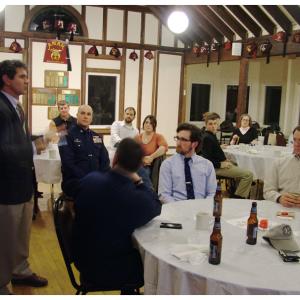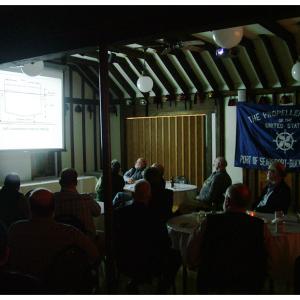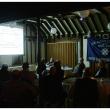Commercial navigators see obvious need for Searsport dredging, no guarantees
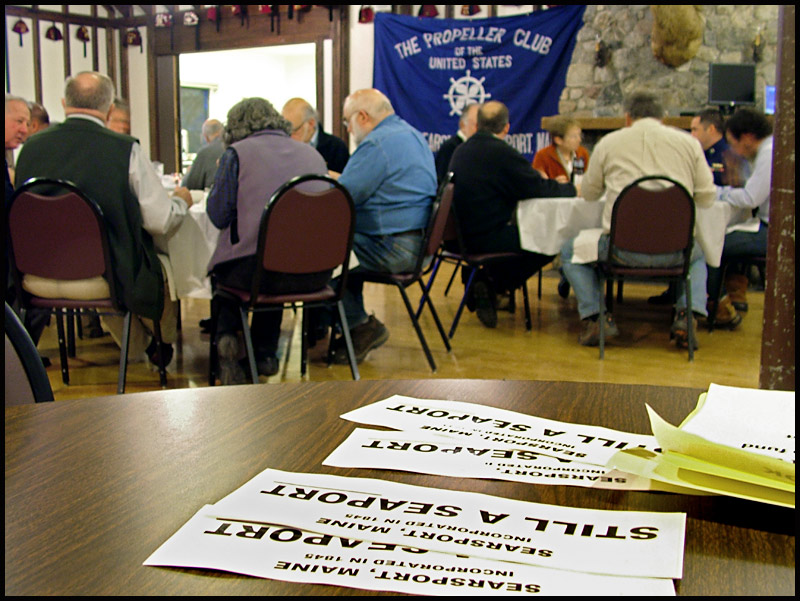 Bumper stickers supporting Searsport’s commercial port displayed at a meeting of the Propeller Club of Searsport and Bucksport, March 19, at the Belfast Shrine Club. The group heard from Captain David Gelinas of the Penobscot Bay and River Pilots Association about a dredging proposal that would enlarge the deep-water shipping channel at Mack Point. (Photo by Ethan Andrews)
Bumper stickers supporting Searsport’s commercial port displayed at a meeting of the Propeller Club of Searsport and Bucksport, March 19, at the Belfast Shrine Club. The group heard from Captain David Gelinas of the Penobscot Bay and River Pilots Association about a dredging proposal that would enlarge the deep-water shipping channel at Mack Point. (Photo by Ethan Andrews)
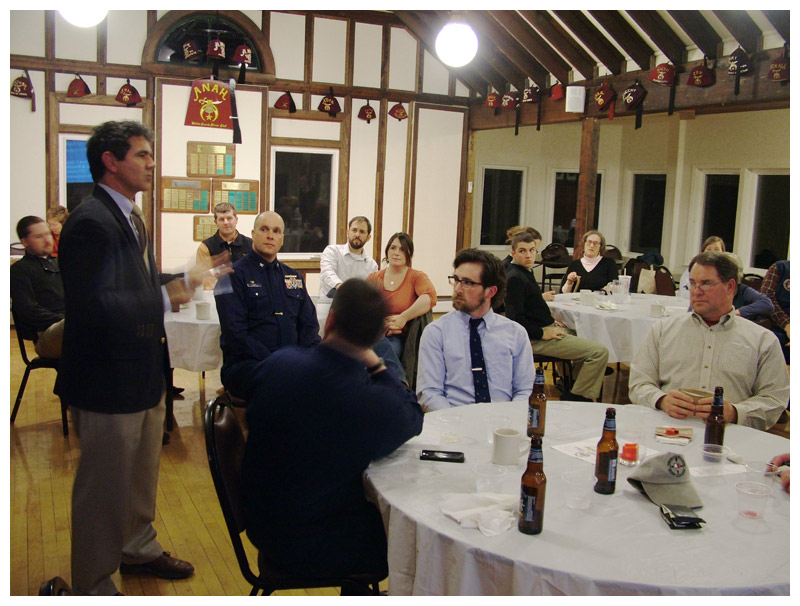 Capt. David Gelinas of the Penobscot Bay and River Pilots Association, left, urges members of the Propeller Club to attend hearings and public meetings on the proposed dredging or risk losing Searsport’s viability as a commercial port. (Photo by Ethan Andrews)
Capt. David Gelinas of the Penobscot Bay and River Pilots Association, left, urges members of the Propeller Club to attend hearings and public meetings on the proposed dredging or risk losing Searsport’s viability as a commercial port. (Photo by Ethan Andrews)
 At the Shrine Club in Belfast, March 19, members of the Propeller Club watch a slide presentation on the logistics of cargo shipping at Searsport’s Mack Point. (Photo by Ethan Andrews)
At the Shrine Club in Belfast, March 19, members of the Propeller Club watch a slide presentation on the logistics of cargo shipping at Searsport’s Mack Point. (Photo by Ethan Andrews)
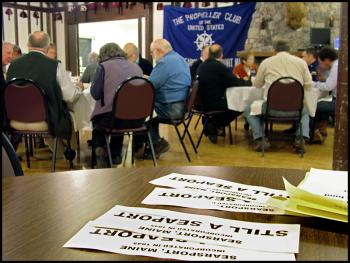 Bumper stickers supporting Searsport’s commercial port displayed at a meeting of the Propeller Club of Searsport and Bucksport, March 19, at the Belfast Shrine Club. The group heard from Captain David Gelinas of the Penobscot Bay and River Pilots Association about a dredging proposal that would enlarge the deep-water shipping channel at Mack Point. (Photo by Ethan Andrews)
Bumper stickers supporting Searsport’s commercial port displayed at a meeting of the Propeller Club of Searsport and Bucksport, March 19, at the Belfast Shrine Club. The group heard from Captain David Gelinas of the Penobscot Bay and River Pilots Association about a dredging proposal that would enlarge the deep-water shipping channel at Mack Point. (Photo by Ethan Andrews)
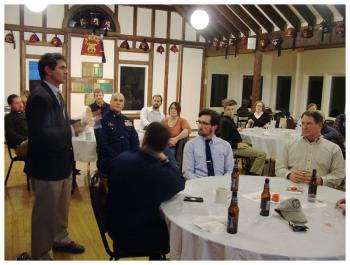 Capt. David Gelinas of the Penobscot Bay and River Pilots Association, left, urges members of the Propeller Club to attend hearings and public meetings on the proposed dredging or risk losing Searsport’s viability as a commercial port. (Photo by Ethan Andrews)
Capt. David Gelinas of the Penobscot Bay and River Pilots Association, left, urges members of the Propeller Club to attend hearings and public meetings on the proposed dredging or risk losing Searsport’s viability as a commercial port. (Photo by Ethan Andrews)
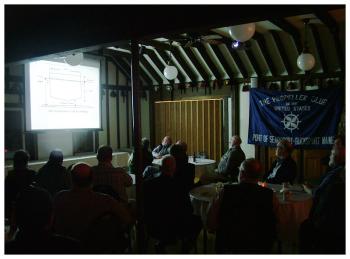 At the Shrine Club in Belfast, March 19, members of the Propeller Club watch a slide presentation on the logistics of cargo shipping at Searsport’s Mack Point. (Photo by Ethan Andrews)
At the Shrine Club in Belfast, March 19, members of the Propeller Club watch a slide presentation on the logistics of cargo shipping at Searsport’s Mack Point. (Photo by Ethan Andrews)
BELFAST - In a presentation to the The Propeller Club of Searsport and Bucksport last week, Captain David Gelinas made a lengthy case for the importance of dredging the channel at Mack Point cargo terminal in Searsport.
In some circles, a current proposal to deepen the channel has caused an uproar. But the Propeller Club, whose members includes active and retired U.S. Merchant Marines, Navy and Coast Guard officers, numerous alumni of Maine Maritime Academy and other veterans of the marine cargo transportation business, didn't need to be convinced.
Afterward, several members joked that he was "preaching to the choir."
As president of the club and one of four captains responsible for safely navigating ships in and out of the cargo port under the banner of the Penobscot Bay and River Pilots Association, Gelinas knew his audience.
He has also been to enough public meetings on the Searsport dredging project to know that despite strong backing from the state and federal government and a feeling among the principal users of the port that dredging is necessary and obvious, the whole thing could easily be scuttled if the opposition wins over the general public.
To use a more political cliche, Gelinas was hoping to "mobilize the base."
The joint project of the U.S. Army Corps of Engineers and Maine Port Authority would deepen the channel in Searsport Harbor by five feet and displace roughly 900,000 cubic yards of sediment. This “improvement” to the original channel has drawn strong objections from grassroots environmental and community activists and a deep-pocketed land trust. It has also been challenged by lobstermen, who see it as a threat to the bay fishery.
The dredging proposal has been in the planning stages for over a decade, but its emergence into the public realm happened to coincide with the end of a two-year battle over a proposal by Colorado-based DCP Midstream to build a major propane terminal and storage tank at Mack Point. Opponents prevailed in that case and built a strong organizational network in the process. For many of the key players, dredging became the new “tank.”
Recent public meetings on the dredging project, have been dominated by opponents. The next meeting, originally scheduled for this week, will be held on April 8 at the University of Maine Hutchinson Center in Belfast.
Gelinas said if supporters don’t show up to back the current plan, the congressional process for selecting dredging projects could mean another 14 years before the opportunity comes around again.
John Worth, a retired tug boat captain, put it more bluntly to attendants.
"If you don't go and if you don’t show up and listen to the arguments and the cases that the Corps of Engineers has made on this ... it will just go away, and [Mack Point] will end up being a barge port,” he said.
The channel was first constructed in 1964. Since then the original 35-foot-deep course has filled in to a mean low water depth of 31 feet. In the meantime ships have become larger on average with deeper drafts. Gelinas showed a slide with depictions of the profile of cargo ships over the years the port has been open. They resembled a balloon being inflated.
Gelinas said the new ships aren’t much longer, but the beam width and draft have increased significantly.
The port can still serve ships with drafts of up to 40 feet, according to the Penobscot Bay and River Pilots Association. But those larger ships must time their arrival with the 12-foot swing of the tides.
Around eight times a year, a ship misses the tidal window and must wait — opponents have seized upon the number as too small to justify any improvement beyond restoring the channel to its original 35-foot depth — but Gelinas said that statistic doesn’t include the ships that come in at less than capacity, or not at all.
A ship called the Star Cosmo made port at Mack Point in January with 40,000 tons of salt. The Supramax-class ship didn't have issues with the tides, Gelinas said, because it came in six-feet lighter than it would have at its 60,000 ton capacity.
"Light loading," as it's known, is a way for carriers to access ports that they couldn't otherwise. The practice potentially allows a carrier access to more ports, but it comes at a cost, and for some companies is simply not worth it.
"If my ship sits for six hours, I've just given up $10,000 that's not coming back," said Ted Matlack, a captain for the Mobile, Ala.-based carrier LMS Shipmanagement.
Matlack, who lives in Tenants Harbor, pilots a 37,000 ton bulk cargo ship. He said it typically carries coal but is capable of transporting "anything you can run out of a chute." With a 40-foot-deep channel, the ship could come into Searsport nearly full, he said, but at the current depth, his company won't bring ships to the port.
Supporters of improvement dredging point to potential new markets in the Central Maine region served by the port via the Montreal, Maine and Atlantic Railway. Often mentioned is a potential export market for Maine-made wood pellets.
Gelinas said dredging the channel would keep Searsport competitive, but said his support for the project is justifiable based on current need alone, not just speculation.
One factor is safety, he said, noting that increasing size of cargo ships and the gradual infill of the channel have made navigation maneuvers unnecessarily hard.
"Ships get very unruly, very unpredictable, when you start smelling the bottom," he said, “It really doesn’t matter if you put the rudder one way, the ship is going to go where she wants to go, unless you have sufficient under-keel clearance.”
"Pilots all over the country deal with set and drift and current,” Gelinas said in anticipation of questions about the safety of operations at the port today. “But the Army Corps of Engineers is supposed to consider what's reasonable ... There's safe and then there's safer, and we'd like to be doing it safer with bigger ships."
On other issues raised by opponents, like the environmental impact of the dredging on the lobster fishery and bay ecosystem generally, Gelinas defers to the Army Corps of Engineers. The federal agency has taken core samples in the dredge area and researched the bathymetry of the proposed dumping site, located in the shipping channel to the northwest of Islesboro, and deemed the process safe.
Opponents have challenged those findings. Some supporters, meanwhile, are questioning how much of the dissent is rooted in real concern for the environment and the lobster industry.
He pointed to the involvement of Islesboro Islands Trust. The conservancy commissioned a high-profile study that arguably tipped the balance in the Searsport Planning Board's decision last year to deny DCP Midstream’s propane terminal application.
In the current battle over dredging Searsport harbor, IIT is among those calling for the Army Corps to undertake a full Environmental Impact Study, rather than rely on the standard Environmental Assessment already completed.
Worth sees this as an act of gamesmanship. An EIS, he said, is "the best way to kill a port."
IIT is currently allied with lobstermen in addition to the grassroots groups from Searsport, Belfast and other coastal towns that opposed the propane terminal. Worth didn't claim to understand why the group was throwing its weight behind efforts to block improvements at Mack Point, beyond possibly wanting fewer cargo ships visible on the water.
"It almost seems like it's a cultural thing," he said. "Like it's about industrialization."
Gelinas expressed a similar view that the conversation was no longer just about dredging, as he urged his audience to contact their federal representatives in support of the project.
“This isn’t a new effort,” he said, referring to the 12 years of planning by the Army Corps of Engineers. “They’ve pretty much reached the end of the road. We are getting into a political realm here, so I think it’s important to follow it through.”
A public meeting on the Searsport dredging proposal, hosted by the Maine Port Authority, will be held on Tuesday, April 8 from 12:30 p.m. to 2:30 p.m. at the University of Maine Hutchinson Center, 80 Belmont Avenue (Route 3), Belfast. The meeting was originally scheduled for March 26, but was postponed due to an expected snowstorm.
Ethan Andrews can be reached at news@penbaypilot.com
Event Date
Address
United States


